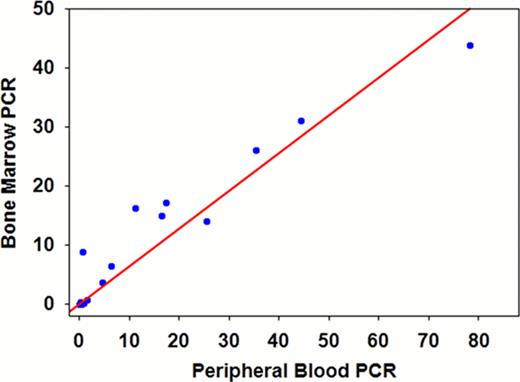Abstract
Monitoring minimal residual disease (MRD) using reverse transcriptase polymerase chain reaction (RT-PCR) for the PML-RARA fusion transcript in bone marrow (BM) samples has been used to predict relapse in patients (pts) with acute promyelocytic leukemia (APL). Rigorous, serial real-time quantitative PCR (RQ-PCR) has been shown to be the strongest predictor of relapse-free survival in APL (Grimwade D, JCO, 2009), and BM was more sensitive than peripheral blood (PB) for detecting pending relapse. However, the clinical utility of MRD monitoring and use of PB as a sample source for MRD detection remains to be established for APL pts treated with ATRA and ATO without chemotherapy.
To evaluate the reliability of using PB real-time quantitative PCR (RQ-PCR) in monitoring MRD in patients with APL treated with ATRA and ATO ± gemtuzumab ozogamicin (GO).
From June 2007 to August 2011, 78 pts with newly diagnosed APL were treated on a clinical trial (NCT00413166) combining ATRA and ATO at our institution. High risk pts (WBC > 10 × 109/L) and pts with rising WBC also received GO on the first day or when WBC rose above 10, respectively. RQ-PCR for PML-RARα fusion transcript was performed on BM and PB after induction, every 3 months throughout consolidation (8 months of ATRA and ATO) for the first 2 years and then PB and/or BM analysis was performed every 6 months with follow up. The Spearman correlation and Paired Wilcoxon test were used to analyze the relation, generate the correlation coefficient and analyze the differences between BM and PB RQ-PCR values.
A total of 432 PB and 618 BM samples were obtained for RQ-PCR analysis. The median number of PB RQ-PCR and BM RQ-PCR obtained per patient were 6 (range, 0–16) and 8 (range, 0–14), respectively. Two hundred thirty six samples were obtained concomitantly from PB and BM (defined as obtained within a day of each other) from 63 patients. The median time to CR was 30 days (range, 9–63). The median time to complete molecular response (CMR) was 130 days (range, 20–271). Two patients died, 1 during induction (before assessing his response to treatment), the other one during 4th consolidation while in CR of unknown cause. Two pts have relapsed, one of them with CNS disease only, the other one with systemic then CNS relapse. Both patients had previously achieved CMR. The patient with CNS relapse remained RQ-PCR-negative on BM at the time of relapse (PB not available at time of relapse). The other relapsed patient had a positive PB RQ-PCR at time of relapse. There was a strong correlation (Spearman correlation, r=0.8, p <0.05) between PB and BM RQ-PCR on the 236 concomitant samples (fig 1); no significant difference were found between quantitative PCR values for BM and PB by paired Wilcoxon test analysis (p = 0.30, paired Wilcoxon test). The patient with systemic relapse (who had secondary APL) was successfully retreated with ATRA+ATO, then with systemic and intrathecal (IT) chemotherapy prior to allogeneic stem cell transplant at second relapse. The patient with CNS relapse was successfully treated with IT chemotherapy.
Among the available paired samples, there is a strong correlation between BM and PB RQ-PCR for PML-RARα fusion transcripts for patients treated with ATRA+ATO. PB RT-PCR is a reliable and practical method to monitor pts in CMR and for possible impending relapse.
Spearman correlation between PB and BM samples obtained concurrently (236 samples) from 63 patients paired (results obtained from 202 RQ-PCR samples were 0 both in PB and BM).
Spearman correlation between PB and BM samples obtained concurrently (236 samples) from 63 patients paired (results obtained from 202 RQ-PCR samples were 0 both in PB and BM).
Off Label Use: Arsenic trioxide is used off label for the treatment of acute promyelocytic leukemia.

This icon denotes a clinically relevant abstract
Author notes
Asterisk with author names denotes non-ASH members.


This feature is available to Subscribers Only
Sign In or Create an Account Close Modal